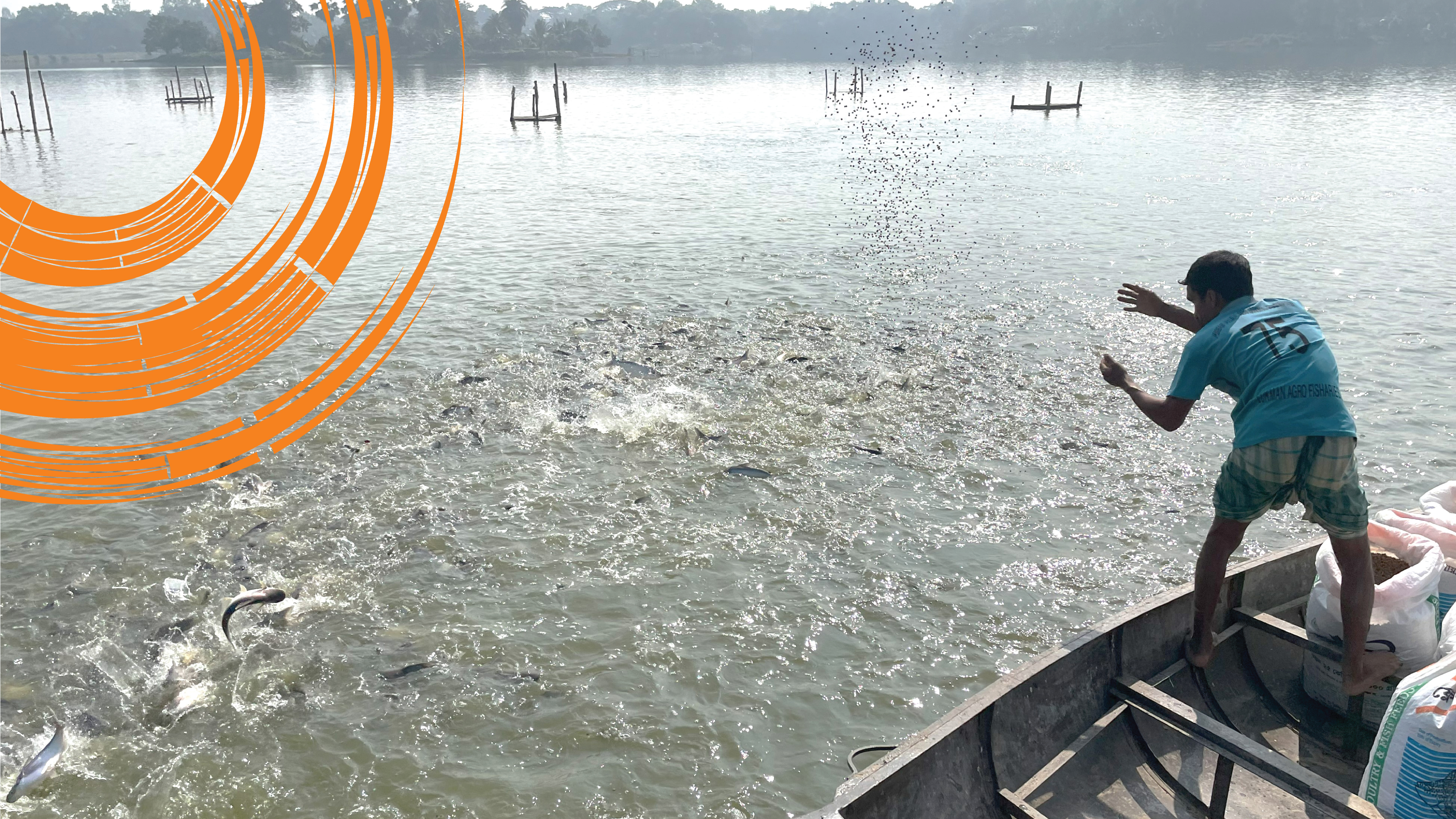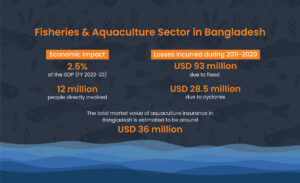
Earlier 2023, Hasmot Ali, a rice farmer from Mymensingh, made a bold decision to convert his paddy fields into fishponds, hoping to make a profit like many of his peers. He invested around USD 8,000 to prepare the ponds, purchase fry, fingerlings, and feed, and hire laborers. For weeks, he worked tirelessly, nurturing the ponds as if they held the key to his future. But in late autumn of 2023, disaster struck. A sudden flash flood ravaged the ponds, sweeping away all the fish. Within hours, Hashmot’s investment was lost, leaving him standing by the empty, muddy fields. Microinsurance can be a lifeline here for people like Hasmot, to give them a chance to rebuild.
Fisheries and Aquaculture sector contributes around 2.5% to the GDP (FY2022-23), providing direct employment to over 12 million people, with countless more involved indirectly. With rising demand and expanding markets, the industry has shown promising potential for further growth and development. However, the sector’s growth and stability are increasingly being threatened by natural disasters.

The situation report on the 2024 Eastern Flash Floods by the ICCG (Inter-Cluster Coordination Group), cluster coordinators, and humanitarian partners estimates a USD 122 million loss in fisheries initially. Studies show that between 2011 and 2020, flooding resulted in a loss of USD 93 million in the aquaculture sector. In 2020 alone, flooding caused USD 28.5 million in monetary loss and led to the loss of 21,156 metric tons of aquaculture production. Over the same period (2011-2020), cyclone-induced economic loss was estimated at USD 28.4 million, with a production loss of 12,480 metric tons.
These immense losses severely affected livelihoods, local economies, and undermined the food security of the country. Given that Bangladesh is the eighth-most climate-vulnerable country, there is a growing need to explore solutions that can mitigate the substantial financial risks faced by the aquaculture sector.
Simply put, microinsurance is a type of insurance specifically designed for low-income individuals, addressing their limited financial resources and specific coverage needs. It offers an effective safety net system that can reshape the fisheries and aquaculture landscape. Unlike traditional insurance, which is often inaccessible due to high costs and complexity, microinsurance is tailored to be affordable, easy to understand, and accessible. It also has the potentials to foster good aquaculture practices as well as increase income and employment of the young men and women in the value chains.
Innovision Consulting’s study on the feasibility and potential of microinsurance for Bangladesh’s fisheries sector with an International Development Organization identified several constraints in the aquaculture insurance market, estimated to be worth USD 36 million. A major challenge is the lack of understanding of microinsurance among farmers, compounded by a general mistrust of insurance products. Additionally, very few insurers are actively targeting untapped markets like aquaculture, partly due to the absence of successful global models to guide them. Support functions also face significant hurdles. There are limited active farmer groups or cooperatives that insurers can partner with to market their products and establish community-led supervision systems at the grassroots level. Moreover, the regulatory environment needs to be more conducive to encourage insurance companies to enter this market.
Large and specialized production clusters present a good opportunity for targeting insurance schemes, as these are more specified, and tend to be less volatile compared to smaller producers. However, the same study by Innovision Consulting found medium and large-scale farmers are highly interested in micro-insurance packages that come bundled with extension services. These services include the supply of good quality inputs (like feed, fry, and fingerlings) and technical advice for managing their aquaculture practices. This is crucial because poor farm management, often driven by cost-cutting measures and low-quality inputs, increases the risk of production failures. Therefore, farmers expect that any viable microinsurance package should not only cover financial risks but also improve their farming practices by providing extension services and ensuring high-quality inputs.
Building on partnerships within the sector can also help develop or scale these schemes. Feed companies, nurseries, and hatcheries can play an important role by supporting farmers with credit, production knowledge, and market access. Many companies already have a good grasp of the risks and opportunities in the value chain, which could help in designing more suitable insurance products. The established bank credit system and past experience in developing insurance distribution networks could also be useful for setting up microinsurance systems through channels like fish feed companies.
Therefore, with proper scheme, microinsurance can provide a vital safety net for Bangladesh’s fisheries and aquaculture sector, giving vulnerable communities a way to protect their livelihoods from nature’s unpredictability. It is a promise of security, a chance to rebuild after loss, and a hope for a future where the next disaster does not mean starting over from nothing.
Author: Sadin Ezaz Choudhury from Business Development and Communications Team at Innovision Consulting